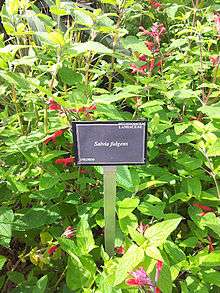Salvia fulgens
| Salvia fulgens | |
|---|---|
 | |
| Scientific classification | |
| Kingdom: | Plantae |
| (unranked): | Angiosperms |
| (unranked): | Eudicots |
| (unranked): | Asterids |
| Order: | Lamiales |
| Family: | Lamiaceae |
| Genus: | Salvia |
| Species: | S. fulgens |
| Binomial name | |
| Salvia fulgens Cav. | |
| Synonyms | |
|
Salvia cardinalis Kunth. | |
Salvia fulgens (Cardinal sage or Mexican scarlet sage) is a species of flowering plant native to the Mexican mountains adjacent to the state of Puebla, growing at 8,700-11,000 ft elevation. It prefers the edge of oak and coniferous woodlands, especially in clearings of Abies religiosa. The mountains receive fog and rain nearly year-round.
Description
Salvia fulgens is a small subshrub growing 50–100 cm (20–39 in) tall by 40–90 cm (16–35 in) wide. The 3 cm (1 in) long flowers grow in loose whorls, and are brilliant red, reflecting the common name and the synonym S. cardinalis. The upper lip has red hairs which glisten (fulgens)[1] in the morning dew. A reddish-brown calyx remains long after the flowers drop. Inflorescences are usually about 4 in long, though occasionally a 12 in inflorescence appears. The heart-shaped leaves are pale yellow-green, about 1.5 in long by 1 in wide, and cover the plant quite profusely.
It was introduced into Western horticulture in the 19th century. It has been grown in Britain for many years.[2] It has gained the Royal Horticultural Society's Award of Garden Merit.[3]
Notes
- ↑ Harrison, Lorraine (2012). RHS Latin for gardeners. United Kingdom: Mitchell Beazley. p. 224. ISBN 9781845337315.
- ↑ Clebsch, Betsy; Barner, Carol D. (2003). The New Book of Salvias. Timber Press. p. 127. ISBN 978-0-88192-560-9.
- ↑ Salvia fulgens AGM, Royal Horticultural Society, accessed July 2012